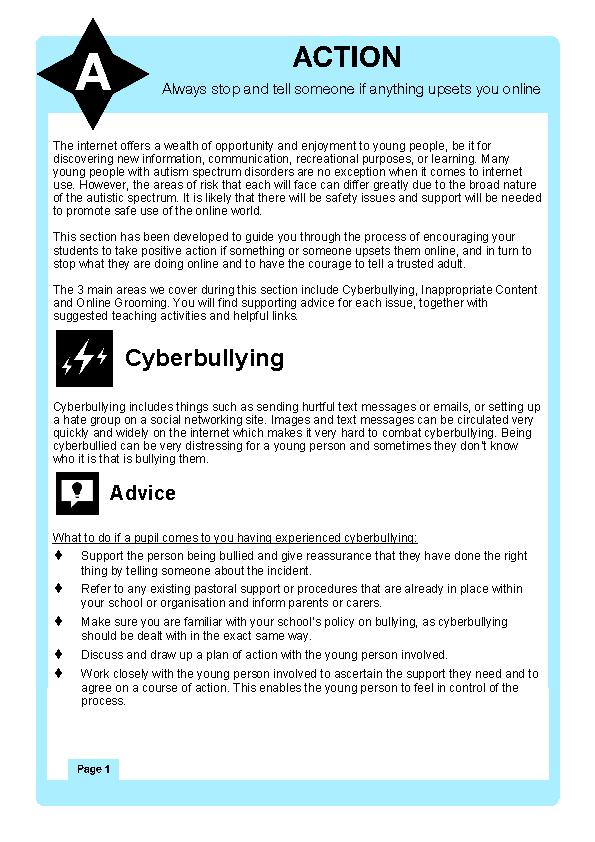The internet offers a wealth of opportunity and enjoyment to young people, be it for discovering new information, communication, recreational purposes, or learning. Many young people with autism spectrum disorders (ASD) are no exception when it comes to internet use. However, the areas of risk that each will face can differ greatly due to the broad nature of the autistic spectrum. It is likely that there will be safety issues and support will be needed to promote safe use of the online world.
This section has been developed to guide you through the process of encouraging your students to take positive action if something or someone upsets them online, and in turn to stop what they are doing online and to have the courage to tell a trusted adult.
The 3 main areas we cover during this section include Cyberbullying, Inappropriate Content and Online Grooming. You will find supporting advice for each issue, together with suggested teaching activities and helpful links.
Cyberbullying includes things such as sending hurtful text messages or emails, or setting up a hate group on a social networking site. Images and text messages can be circulated very quickly and widely on the internet which makes it very hard to combat cyberbullying. Being cyberbullied can be very distressing for a young person and sometimes they don’t know who it is that is bullying them.
 Advice
Advice
What to do if a pupil comes to you having experienced cyberbullying:
- Support the person being bullied and give reassurance that they have done the right thing by telling someone about the incident.
- Refer to any existing pastoral support or procedures that are already in place within your school or organisation and inform parents or carers.
- Make sure you are familiar with your school’s policy on bullying, as cyberbullying should be dealt with in the exact same way.
- Discuss and draw up a plan of action with the young person involved.
- Work closely with the young person involved to ascertain the support they need and to agree on a course of action. This enables the young person to feel in control of the process.
Next steps – how to create your plan of action:
- Advise your pupil to save the evidence and not retaliate. Advise them how they can block people and how to use their privacy settings.
- Take action to contain the incident when content has been circulated. Steps may
- include:
| – asking the person responsible to take the content down | |
| – reporting the content online yourself | |
| – contact the UK Safer Internet Centre’s helpline for professionals | |
| – consider disciplinary powers to confiscate devices that are being used to cyberbully; and, | |
| – contacting the police if the law has been broken. |
- Investigate the incident – keep a record. If necessary, take steps to identify the person displaying the bullying behaviour.
- Work with the young person displaying the bullying behaviour. It is also important to support the young person who has bullied and to look at the possible causes for their behaviour. For example, they may have been bullied themselves, or may not
- understand how their behaviour and actions have affected others.
Search engines play a primary role when using the internet. Whether you are looking for a particular website or want to research a subject matter by using one key word, the internet can offer a wealth of information. However, with this also comes the obvious risk of encountering inappropriate or upsetting images. Young people with ASD may be even more vulnerable to this, especially if they have limited typing skills and are more vulnerable to mistyping words. For example, learners with ASD might be more inclined to use one word searches due to their limited typing skills. It’s important to be as clear as possible when searching online, that’s why it’s important to encourage using multiple words when researching through a search engine. Without appropriate filtering or parental controls in place, the risks are far greater in regards to accessing inappropriate content.
In addition to this, accessing this type of content poses the additional challenge of helping young people to be able to identify what is considered to be inappropriate and how best to respond to it. It’s important to understand that no filter or parental control is 100% full proof. This is why a conversation needs to be had about inappropriate and appropriate content online. The nature and level of this conversation will vary depending on the needs of the young person that you’re speaking with.
 Advice
Advice
What you can do if a pupil comes to you having experienced something inappropriate online
Should a pupil share with you that something has upset them online, such as indecent or upsetting images, videos or websites then always reassure in the first instance that they have done the right thing in telling you. The causes may differ greatly but this course of action could be followed and adapted accordingly.
- Ask what they have seen and what they think or feel about the image or content ie. what it is that has made them uncomfortable and why?
- Discuss what is considered to be appropriate and inappropriate content and balance this with the reasons why it is inappropriate and how it has made them feel uncomfortable. For example:
One teacher we spoke to had experience of their pupil typing the word ‘girls’ into Google. At the time, this was what this pupil was interested in so it was natural for him to explore this interest. Sometimes appropriate searches may show inappropriate results and that’s why it’s important to have conversations with your pupils about what’s appropriate and what’s inappropriate to look at online. During these conversations, make sure you always reassure them that they can come to you if anything worries or upsets them on the internet. Once they come to you, together you can talk through how looking at this type of content online is sometimes not appropriate, particularly if the young person is in school.
- Discuss where and how did they come across or find this content? If it was something that occurred during school, then investigate what has happened with the filtering system you have in place. Should the content have been viewed at home then decipher how this occurred. For example, it may have been shared by a sibling. There may be reason to speak to a parent or carer to alert them of this.
- Reassure them that you are a trusted adult and they are right and safe to tell you if something like this happens. This will enable you to initiate a conversation about who else they consider to be a trusted adult.
- Create an action plan with your pupil on how to avoid or manage a situation like this in the future. Please do refer to our section on safe searching for further advice in the TRUST section.
Online grooming is the process by which someone with a sexual interest in children will approach a child online, with the intention of developing a relationship with that child, to be able to meet them in person and intentionally cause harm. In many cases it can be an adult contacting a child under the guise of a false identity (i.e. pretending to be a teenager). This is an area in which young people with ASD are particularly vulnerable as they may perceive everything told to them by another person online to be the truth, may not question the directions in which online conversations head and may not realise the importance of not meeting up in person with someone they’ve only met online.
Use of the resources and information in the TRUST section of the toolkit is a useful way to raise this issue and explore the messages further with your pupils. In particular, discussing the pressure that young people may be put under to send pictures/videos to others online and the importance of making positive choices and staying in control of the details they share online.
 Advice
Advice
It is important to stress to young people with ASD that if they feel uncomfortable or worried about anything that anyone says online to them that they should stop and tell a trusted adult. However, it is important to realise that in this particular, young people with ASD needs may not be aware that they are being groomed, and may not respond in the same way as they would to negative or bullying comments made by others online.
Therefore if you are at all concerned that a child in your care has been contacted by an adult online, it is imperative to tell someone straight away.
- Ensure that you are familiar with reporting procedures in your workplace and that confidentiality is not promised to the child in question.
- Report immediately to the designated person, for example the Child Protection Officer so that the correct steps are taken from the outset.
- Ensure that the child’s own words are used and are not changed in any way. The child or young person in question may want to accompany you when you make your report, to be part of the process.

